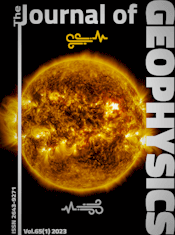Joint magnetometer array and radar backscatter observations of auroral currents in Northern Scandinavia
Article Sidebar

Vols. 1-18 (1924-1944), ISSN 0044-2801
Main Article Content
Abstract
As a contribution to the International Magnetospheric Study the University of Munster has installed an array of 32 Gough-Reitzel type magnetometers located mostly in Northern Scandinavia. Also for the IMS, the Max Planck Institute for Aeronomy at Lindau is operating the Scandinavian Twin Auroral Radar Experiment (STARE) which consists of two nearly identical backscatter radars located near Trondheim (Norway) and Sauvamaki (Finland). For a weak isolated substorm on October 7, 1976 the spatial structure of the electron density irregularities observed by the Trondheim-radar and the equivalent current distribution derived from the magnetic measurements have been compared. A good correspondence has been found between the location and magnitude of the maxima of the horizontal magnetic disturbance and the radar backscatter amplitude for an eastward electrojet. For most of the comparison there appeared also to be good agreement between the direction of the equivalent current and the direction antiparallel to the line-of-sight irregularity drift. This supports the idea that the backscatter irregularities are caused by current driven plasma instabilities and that it is possible to determine auroral ionospheric currents with the backscatter radar technique. However, during periods of enhanced electron precipitation, differences between the drift directions given by the two methods were observed.
 ARK: https://n2t.net/ark:/88439/y099827
ARK: https://n2t.net/ark:/88439/y099827
Permalink: https://geophysicsjournal.com/article/250
Article Details
References
Ecklund, W. L., Balsley, B.B., Carter, D.A. (1977) A preliminary comparison of F region plasma drifts and E region irregularity drifts in the auroral zone. J. Geophys. Res. 82:195-197
Farley, D.J. (1963) A plasma instability resulting in field-aligned irregularities in the ionosphere. J. Geophys. Res. 68:6083-6097
Fukushima, N. (1976) Generalized theorem for no ground magnetic effect of vertical currents connccted with Pedersen currents in the uniform conductivity ionosphere. Rept. Ionos. Space Res. Japan 3O:35-40
Gough, D.I., Reitzel, J.S. (1967) A portable three component magnetic variometer. J. Geomag. Geoclectr. 19:203-215
Greenwald, R.A., Ecklund, W.L., Balsley, B.B. (1973) Auroral currents, irregularities, and luminosity. J. Geophys. Res. 78:8193-8203
Greenwald, R.A., Ecklung, W.L., Balsley, B.B. (1975) Radar observations of auroral currents. J. Geophys. Res. 80:3635-3641
Gustafsson, G. (1970) A revised corrected geomagnetic coordinate system. Ark. Geofys. 5:595-6l7
Harang, L. (1946) The mean field of distubance of polar geomagnetic storms. Terr. Magn. Atmos. Elec. 51:353-380
Kamide, Y., Brekke, A. (1977) Altitude of the eastward und westward auroral electrojets. J. Geophys. Res. 82:2851-2853
Kuppers, F., Untiedt, J., Baumjohann, W. (1978) A two-dimensional array for ground-based observations of auroral zone electritc currents during the IMS. Submitted to J. Geophys.
Rogister, A., D'Angelo, N. (1970) Type II irregularities in the equatorial electrojet. J. Geophys. Res. 75:3879-3887
Siren, J.C., Doupnik, J.R., Ecklund, W.I. (1977) Comparison of auroral currents measured by the Chatanika radar with 50 MHz backscatter observed from Anchorage. J. Geophys. Res. 82(25):3577
Stauning, P., Christensen, B. (1977) Compilation of Ionlab riometer data for IMS-Workshop in Hankasalmi. Ionlab Rep. R41. Lyngby (Denmark)
Tsunoda, R.T., Presnell, R.I., Kamide. Y., Akasofu, S.-I. (1976) Relationship or radar aurora, visual aurora, and electrojets in the evening sector. J. Geophys. Res. 81:6005-6015











